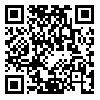Volume 7, Issue 5 (2016)
LRR 2016, 7(5): 283-308 |
Back to browse issues page
Download citation:
BibTeX | RIS | EndNote | Medlars | ProCite | Reference Manager | RefWorks
Send citation to:



BibTeX | RIS | EndNote | Medlars | ProCite | Reference Manager | RefWorks
Send citation to:
abbasi M, oveisi A, savab F. Lexical Cohesion in the Surrealistic Text of Blind owl by Sadeq Hedayat based on Halliday and Hasan's Theory. LRR 2016; 7 (5) :283-308
URL: http://lrr.modares.ac.ir/article-14-6190-en.html
URL: http://lrr.modares.ac.ir/article-14-6190-en.html
1- Assistant professor of Persian language and literature, University of Sistan and Baluchestan, Zahedan, Iran
2- Associate Professor of Persian Language and Literature, University of Sistan and Baluchestan, Zahedan, Iran
3- Ph.D. student of Persian language and literature, University of Sistan and Baluchestan, Zahedan, Iran
2- Associate Professor of Persian Language and Literature, University of Sistan and Baluchestan, Zahedan, Iran
3- Ph.D. student of Persian language and literature, University of Sistan and Baluchestan, Zahedan, Iran
Abstract: (6426 Views)
Functional linguistics is regarded as one of the dominant approaches in contemporary linguistics that focuses on the functions of language. The greatest theoretician of functional linguistics Michael Halliday, in cooperation with Roqaye Hassan, have investigated the unity and coherence of text and have categorized its elements in Cohesion in English. The theory of the unity and coherence of text, which is based on the relations of sense and text, is considered as a branch of discourse analysis that investigates text. Coherence has an important and significant role in the structure of a text. The author reflects his real and surreal world in the text. Though time coherence is subverted in this reflection, he conveys meaning and creates text through language and maintaining lexical and syntactic relations.
Surrealist writers attempt to create imaginary and unreal milieus by means of free imagination and the unconscious to reach at a world beyond reality and away from preoccupations of contemporary culture. Since the surreal text is a reflection of surreal world free from limitations of language (automatism), it is assumed that such texts possess no unity and coherence and semantic relations in them is chaotic. Accordingly, this study investigates lexical cohesion of Blind Owl, in a descriptive-analytic method, based on Halliday and Hassan’s theory. The present research seeks answers to the following questions: Does the overflow of lexicons, originating from automatic writing out of the hallucinations of surrealist writer, create an incoherent text or not? Does the surrealist text take distance from language standards and their lexicons and their sentences have no unity and coherence as surrealists do in their real life? At last, it is argued whether Halliday’s linguistic theory can be useful in the analysis of surrealist texts in order to understand writer’s mentality and spirit.
Surrealist writers attempt to create imaginary and unreal milieus by means of free imagination and the unconscious to reach at a world beyond reality and away from preoccupations of contemporary culture. Since the surreal text is a reflection of surreal world free from limitations of language (automatism), it is assumed that such texts possess no unity and coherence and semantic relations in them is chaotic. Accordingly, this study investigates lexical cohesion of Blind Owl, in a descriptive-analytic method, based on Halliday and Hassan’s theory. The present research seeks answers to the following questions: Does the overflow of lexicons, originating from automatic writing out of the hallucinations of surrealist writer, create an incoherent text or not? Does the surrealist text take distance from language standards and their lexicons and their sentences have no unity and coherence as surrealists do in their real life? At last, it is argued whether Halliday’s linguistic theory can be useful in the analysis of surrealist texts in order to understand writer’s mentality and spirit.
| Rights and permissions | |
 |
This work is licensed under a Creative Commons Attribution-NonCommercial 4.0 International License. |






